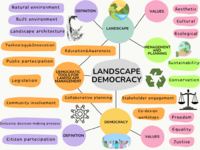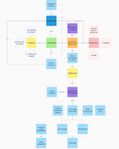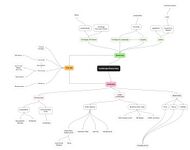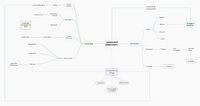Democratic Landscape Transformation 2024 - Team 2
>>> Back to working group overview
>>> Back to seminar reading list
>>> go to the Editing Help
Background of your team
Please present your team briefly. Which linguistic and cultural perspectives does each member bring in? Which disciplinary backgrounds are present in your team?
Marius Wolf
- civil engineer and permaculture designer from Germany, having lived in Indonesia and Portugal, sharing a passion for developing inspiring and regenerative landscapes (that’s the WHY for currently studying IMLA).
Marica Ruggiero
- University student of the Building Engineering-Architecture course, I was born and raised in Southern Italy and I moved to the city of Bologna to study, facing a new life path with a passion for architecture, urban planning and landscape
Katerina Tsoni
- Undergraduate student in the Agricultural University of Athens, with a specialization in Floriculture and Landscape Architecture. I grew up in Athens, Greece. Despite Greece being the "homeland" of Democracy, the landscape, especially the urban one, is not very democratic.
Khadija Sarwar
- I graduated in Architectural Engineering from Pakistan, I was born in Pakistan and completed my whole education period till bachelors in my homeland. I chose landscape to pursue study because Pakistan is facing big issues related to climate change, so I want to add minor value, being a part of my country.
Your Landscape Democracy Manifestoes
Here you can add links to the manifestoes you have presented on April 24. Please make sure that the links are accessible. You can also add them directly here on the wiki, they need to be png or jpg format then.
- TEDx : Water and Life (https://www.youtube.com/watch?v=kPKUA7iJZwo)
- Marica Ruggiero: https://www.canva.com/design/DAGDId7ynfI/CTOfxg8t2dqW9LVmN2tGGw/edit
- Khadija sarwar: https://docs.google.com/presentation/d/1VFkn7TrHUsJORh2gqmjP2dmbINSklgmc1wvHr6q6EJk/edit?usp=sharing
Readings, concepts and definitions
- Start: April 3, 2024
- Due: July 2, 2024
While working in your group, please start to express your personal understanding of the relation of landscape and democracy in the form of a concept map with linking words or any other diagrammatic representation. Please make your maps very visual and not just verbal. Think critically about why one map differs from another.
The final product is a shared concept map that integrates the various understandings present within your team.
About concept mapping
Before starting the exercise you can read this article by Joseph D. Novak & Alberto J. Cañas about Theory Underlying Concept Maps and How to Construct and Use Them. This paper gives a good explanation of how concept maps are conceived and developed.
You can use any tool you like for producing your concept map. However, since the result needs to be submitted digitally we recommend the following open source software for producing your maps:
- Cmap Tools >>> you can also work with your group on the Cmap cloud doing a shared map
- VUE - The Visual Understanding Environment
- Use a shared whiteboard to develop your integrated concept map, such as MIRO or MURAL
How to present your concept maps
- Possible format: JPG (for wiki upload) or link to any other resource
- We give you below a draft image gallery where you can add pictures of your map (in JPG or PNG format)
- You can present your integrated understanding as one concept map or your present individual ones and the integrated one.
- add as many additional materials as you need
Overview of your concept maps (individiual and integrated)
Reflection
What are the similarities and differences in your team regarding your understanding of what democratic landscape transformation is?
Each of us within the team expressed our own personal concept of landscape democracy, delving into crucial aspects such as definitions, values, individuals involved, management, and goals of this issue. Through shared reflection, each person contributed to outlining a comprehensive and multifaceted picture of what landscape democracy means, enriching it with unique perspectives from their own personal experiences and knowledge: some paid more attention to a social perspective, some treated the topic more from an ecological perspective, some focused on the concept of law, and some looked more at the aspect of biodiversity. In the end, however, the overall picture turns out to be complete and shared by all group members.
In how far did the seminar lectures and readings help you to clarify this?
The seminar's lectures and readings were instrumental in clarifying our understanding of landscape democracy. Practical examples from practitioners demonstrated how theoretical concepts provided by the various readings provided are applied in real-world spatial contexts. Additionally, the breakout sessions and team reflections in the classes deepened our comprehension.
In the following we give some examples for each of the above mentioned elements of the course:
- Breakout Sessions and Reflections: Discussing local landscape challenges using four pictures of different places highlighted how democratic landscape challenges can be perceived differently and how straightforward solutions can make a significant impact. The main lesson was the importance of listening to each other and the crucial role of effective communication.
- Reading Insights: Faurest, Kristin (2018): "Listening to Nature - and Each Other": This reading emphasized the importance of trusting our experiences as landscape architects and using them to create a more sustainable and socially cohesive world.
- Practitioners' Presentations: "Urban Heat Watch" Project: This project illustrated how citizen science (using an app) can be combined with advanced technology (drones and climate sensors) to allow users to interact directly with the results (heat maps). It not only generates robust data but also enhances user learning (e.g., feeling the cooling effect of trees and seeing it visualized on a map), fostering a sense of ownership and stewardship for the city.
What will you take home from this seminar?
Reflecting on the seminar, the most significant insights revolve around the collaborative design process and the practical application of theoretical knowledge:
- Collaborative Design Approach: This participatory method involves stakeholders, designers, and other relevant parties working together throughout the design process, necessitating transparency and inclusiveness within the community.
- Prototyping as Engagement: Prototyping is an effective method for collaborative design. One memorable example involved designing a play area for school children. The process engaged not only the children but also their parents and teachers. Exercises to gather children's preferences through their favorite game pictures and building blocks activities provided valuable insights into their likes and dislikes.
Conclusion
In conclusion, the seminar highlighted the significance of participatory methods and the practical application of landscape democracy principles. The collaborative approach to design, the importance of effective communication, and the use of prototyping as an engagement tool are key takeaways that we will carry forward in our professional practices. The lessons learned will guide us in creating landscapes that are democratic, sustainable, and reflective of the diverse needs and values of the communities and individuals they serve.




